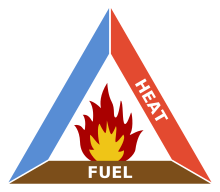User:Johny UT
| This user is a student editor in Wikipedia:Wiki_Ed/University_of_Oregon/Fire_and_Natural_Disturbances_(Fall_2017). Student assignments should always be carried out using a course page set up by the instructor. It is usually best to develop assignments in your sandbox. After evaluation, the additions may go on to become a Wikipedia article or be published in an existing article. |

The Fire Triangle
[edit]The fire triangle, which is also known as the combustion triangle, is a model for understanding the chemical reaction which must happen to create fire. It is composed of three elements that include fuel, heat, and oxygen, which must all be present for a fire to ignite. The fire triangle can be used as a form of fire safety training, by looking and understanding the side of the triangle in more detail. The fuel is any kind of combustible material, including paper, oils, wood, gases, fabrics, liquids, and plastics. The fuel for a fire is usually characterized by its moisture content, size, shape, and quantity and is determined of how easily the fuel will burn and at what temperature. In addition to a fuel source, heat must be present for ignition to occur. Flammable materials give off vapors and when heat is present it can ignite. Heat is responsible for the spread of fire as it removes moisture from nearby fuel, warming the surrounding area and heating of fuels in its path. With fuel and heat, fire needs oxygen to stay lit. Ambient air is made up of around 21% oxygen and most fire only require at least 16% oxygen to burn, it acts as an agent the chemical reaction, which means that when the fuel burns, it reacts with the oxygen to release heat and generate combustion.[1]
Multi-scale triangle for wildland fires
[edit]In the context of wildland fire, the fire triangle can be scaled up to apply to understand fire spread over landscapes (scales of days and several km) and recurrence of fire over time (scales of decades and hundreds of km). Thus, while heat is important to ignite a flame, topography is important for aiding fire spread especially by preheating upslope fuels, and ignitions sources are important to help explain recurrence on longer time scales. Similarly, while oxygen is relevant to sustain a flame, weather and associated winds feed oxygen into a spreading fire, and the longer-term pattern of weather is summarized as climate. Lastly, fuels is the term to describe what burns in a single flame to the range of materials burnt in a spreading wildfire, but fuels vary over larger space and time scales in what is called vegetation.

At the smallest scale, the combustion fire triangle, individual fuel particles are ignited once at a critical temperature, and fire transfers energy to the nearest surroundings. Combustion events range on the scale of several seconds to a couple of days and their effects are monitored at the quadrant scale. The largest scale, in contrast, describes the fire regime concept. Global climate change drives the influence of greater fire incidences, but a key understanding of those influences is the notion of fire regime, where different vegetation has characteristic fires in terms of recurrence, intensity, seasonality and biological effects. Fire can also have properties with the factors of vegetation type and current climate conditions.[2]
Wild Land Fire and Suppression
[edit]Fire is a natural disturbance process that changes the ecosystem, shapes vegetation, impacts biodiversity, and shifts carbon from land and water to the atmosphere. Fuel serves as the main input component for fire danger, behavior, and spread. Weather and climate are important factors to wild land fire behavior.
Natural wild land fires are generally caused by lighting, other natural caused include sparks from falling rocks and volcanic activity. Human activity is the primary cause of wild land fires. Some are fire is set intentionally for fire prevention and others accidental. The three primary classes of wild land fires are ground, surface, and crown. Ground fires are intense blazes that destroy all vegetation and organic matter. Surface fires burn rapidly at low intensity and burn light fuels with little danger to mature trees and root systems. Crown fires are generated by ground fires and occur in the upper sections of trees, which cause embers and branches to fall and spread fire.
To suppress fire, one of the three elements of the fire triangle must be removed. If a fire runs out of fuel, it will smolder out. A fire can be cooled down to lose heat and will go out. If the oxygen is removed from and around the fire will suffocate. Wildfire suppression uses a range of tactics to help combat fire. Effective fire management planning requires information on the benefits and risks to a wide variety of values at landscape scales, integration with land management objectives, and a long-term perspective.[3]
- ^ Stauffer, E., & NicDaéid, .N. (2013). Chemistry of Fire. In Encyclopedia of Forensic Sciences(pp. 161-166).
- ^ Scott, A., Bowman, D. M. J. S, Bond, William J., & Alexander, Martin E. (2013). Fire on earth : An introduction. Chichester, West Sussex: Wiley Blackwell.
- ^ Miller, C., Landres, Peter B, & Rocky Mountain Research Station. (2004). Exploring information needs for wildland fire and fuels management (General technical report RMRS ; GTR-127). Fort Collins, CO: U.S. Dept. of Agriculture, Forest Service, Rocky Mountain Research Station.
